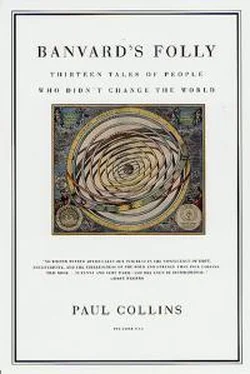The most complete account of Bull is Edmund Schofield's in the Fall 1988 issue of Arnoldia; shorter accounts can also be found by Barbara Wallraff in the January/february 1980 issue of Garden, by Dorothy Manks in the October 1966
issue of Horticulture, and in the Fourth Quarter 1910 issue of The American Breeders Magazine. The Meehan's Monthly editorial is in the March 1894 issue.
All are available through the University of California at Berkeley. Finally, U. P. Hendrick's A History of Horticulture in America (1950) does not discuss Bull much, but does give a well-researched context for understanding him and the rise of native hybridization and seed propragation in his era.
GEORGE PSALMANAZAR
Much of my chapter is drawn from Psalmanazar's own remarkable work, Memoirs of com--- (1765). It is shocking that this book has been out of print for more than three hundred years now. Copies can be found, fortunately, at a number of major research libraries, such as the New York Public Library, the Library of Congress, and the University of California at Berkeley, and in the rare book room of the San Francisco Public Library. It is slightly easier to find his infamous fraud An Historical and Geographical Description of Formosa (1704).
It went through a second edition in 1705 and multiple pirated and translated editions; in 1926 a small run (750 copies) of facsimile copies of the first edition were printed. Many major research libraries have either the original or the facsimile lurking in their rare book rooms--or at least they think they do. When I asked for one such Psalmanazar volume at the New York Public Library, it was found to be "missing." Psalmanazar books fetch thousands of dollars, and I suspect that someone knew the value of that book better than the library did.
The Dictionary of National Biography has a wonderful and exhaustive entry on Psalmanazar, longer than most of its entries for kings and prime ministers.
More recently, Justin Stagl's A History of Curiosity: The Theory of Travel 1550-1800 (1995) has an excellent chapter on Psalmanazar. The standard biography, though, remains Frederick J. Foley's The Great Formosan Impostor (1968). It is not an easy book to find, although the New York Public Library has a copy. It was published through the Jesuit Historical Institute--oh, Psalmanazar would be horrified--and is a well-researched and even-handed volume. And to date, no one has had any luck at guessing Psalmanazar's real identity, but I often wonder whether the name of his "Formosan philosopher"
Chorche Mathcin is some kind of clue.
ALFRED ELY BEACH
Beach is his own best source. His marvelously illustrated 1868 volume The Pneumatic Dispatch can be found at the Science and Business branch of the New York Public Library, as can the General Description of the Broadway Underground Railway (1871) and To the Friends of Rapid City Transit (1871).
For the opposition, see Unanswerable Objections to the Broadway Underground Railroad (1873). For a Beach railway postmortem written while it was still in living memory, see James Blaine Walker's Fifty Years of Rapid Transit (1917).
And the late attempt at a London pneu railway appears in the July 12, 1877, issue of Nature.
Modern railway enthusiasts are a fine source of misinformation on Beach. I do recommend, though, Charles Hadfield's exhaustive history of British pneumatic railways, Atmospheric Railways: A Victorian Venture in Silent Speed (1967).
For a sense of Beach's wide-ranging interests in science and technology, just read any pre-1896 issue of Scientific American, or his wonderful (if short-lived) annual Science Record (1873). Anyone with a serious interest in his railway should also read through the 1867-to-1872 volumes of his magazine.
The outlines of the man himself can be sussed out from the obituary on the front page of the January 11, 1896, issue of Scientific American.
Finally, there is one very simple way to see what Beach's railway looked like, and blown up far larger than any plate in this book could manage. Go to a Subway shop--the fast-food chain, you know, where you can buy a six-inch Cold Cut Trio?--and lo! Pasted upon the walls are pictures of Beach's invention.
Whoever was designing the chainwide decor for Subway simply clipped out a bunch of old public-domain illustrations of subways, including three that originally ran in Scientific American in the 1870's. Look for the pictures that depict an almost perfectly round (save for a slight groove in the bottom) brick-lined subway tunnel, and a rounded subway car interior. These are
Beach's own handpicked illustrations for what was to be an ultra-million-dollar venture.
Graze pensively on your Baked Lay's Sour Cream and Onion chips. Ponder the vagaries of ambition.
MARTIN TUPPER
No matter how obscure he becomes, the sheer tonnage of his published output ensures that there will always be a Tupper--though you're more liable to find him as a prop book in a furniture store than on any library shelf. Still, almost any used-book web site or antiquarian dealer will have a few copies of Proverbial Philosophy or Complete Works around, often quite cheaply. Since it was published in a small run, long after his popularity had faded, it is harder to find his autobiography, My Life as an Author (1886), though the University of California at Berkeley has a copy. (bizarrely, a Spanish translation-Autobiografia--turned up in Rio de Janeiro in 1969. The New York Public Library has one.) His numerous other efforts are also floating around used-book stalls, and all are at the the New York Public Library; the parodies that these efforts earned can be found in Volume 6 of Walter Hamilton's Parodies of the Works of English and American Authors (1889).
Tupper's obituary can be found in the November 30, 1889, issue of the London Times, p. 10, while there is a postmortem of Tupper's reputation in the February 26, 1938, issue of the Times Literary Supplement, p. 137. John Drinkwater damns him with faint derision in his contribution to the critical collection The Eighteen-eighties (1930). Just about the only other article on him is an interesting sidelight on his American tour and his relationship to Whitman: "To Destroy the Teacher: Whitman and Martin Farquhar Tupper's 1851
Trip to America," published in the Spring 1996 issue of the Walt Whitman Quarterly Review, pp. 199-209.
There is very little book-length scholarship on Tupper. Only one biography has been written: Derek Hudson's fine Martin Tupper: His Rise and Fall (1949), which is surprisingly easy to find used or at major libraries. The only critical study of his work is a curious obscurity by Ralf Buchmann, Martin F.
Tupper and the Victorian Middle Class Mind, published in Bern in 1941. It was originally written as a thesis for the University of Zurich. It makes for amusing reading, because Buchmann really despises Tupper--though often Tupper is just a convenient stand-in for everything about Victorianism than Buchmann hates. Still, it's strange that in the midst of the greatest slaughter of this century, this grad student spent months jumping up and down on the cold corpus of an author that nobody even reads anymore.
ROBERT COATES
The only book-length account is John Robinson's 1891 biography The Life of Robert Coates. It's rather padded out, but essential nonetheless. I've never found it for sale anywhere, but both the New York Public Library and the University of California at Berkeley have copies.
Contemporary accounts can be found in Reminiscences and Recollections of Captain Gronow (1862) by Rees Gronow and in the March 1813 issue of The European magazine, pp. 178-83; this article also has the best-known engraved portrait of Coates. UC Berkeley has an original print copy of this magazine in an impressively weighty and beautifully tooled old binding. It was with great reluctance that I finally returned it.
Читать дальше











